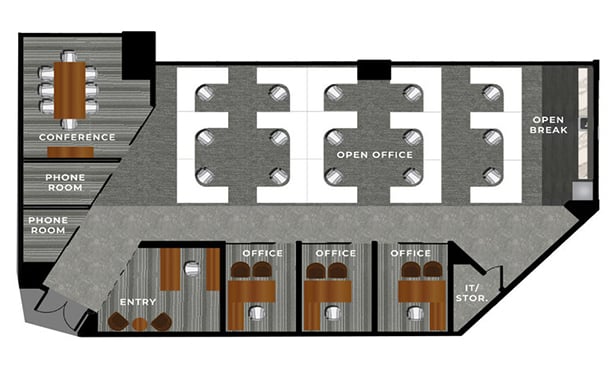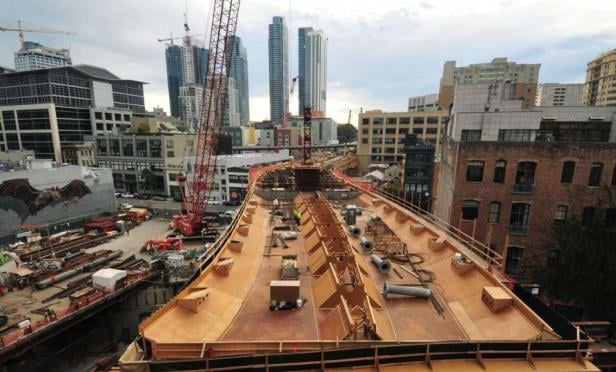
Lenders and borrowers in New York City must be cautious of a requirement that can add significant time and costs to development projects. The New York City Department of Building mandates in BC Section 3309 that the entity undertaking the construction or demolition work protect adjoining buildings. However, in order to provide the protection, whether it be underpinning or roof protection, written approval to access the neighboring properties must be obtained from the owners of the those properties. Many property owners will demand payment to provide the required access to the developer. Of course, financial compensation may be warranted if a neighboring property is negatively impacted by a construction project, but more often than not building owners see the “access agreement” or “license fee” as an opportunity to receive a large payoff or even block construction.
Indeed, the requirement is prone to abuse, and can add risk for lenders and developers by adding unforeseen costs and delays to construction projects. In an ongoing court case, for example, a prominent real estate developer is accused of extortion and purposely stalling a construction project.
The Hidden Risk of Difficult Neighbors
I've been involved in numerous projects that have suffered extended delays because the developers got caught in negotiations for underpinning, roof protection and sidewalk sheds that lasted for months (in one case, even two years!). These projects also suffered from cost overruns as work came to a stop during the negotiations while general conditions costs continued and in some cases foundations were redesigned, with more costly foundation solutions implemented to avoid underpinning.
Importantly, the access agreement negotiations are usually hidden from the bank. License fees are often paid directly by the borrower and do not show up on construction budgets. Fees required to gain access to neighboring properties reduce available cash to pay for change orders and cost overruns and can significantly impact the developer's ability to service a loan. And because parties on both sides tend to be reluctant to discuss any negotiations they've had, many lenders and developers new to the New York City market are unaware of the risk difficult neighbors can create.
How Developers Can Avoid Costs and Delays
The best way for a developer to address access agreements is to speak to the owners of properties neighboring a project as soon as possible, ideally in the early stages of the design process. The earlier a neighbor is dealt with the less leverage they will have. If a neighbor appears truly difficult at this stage, it may be worth the effort and additional cost to redesign the foundations and avoid underpinning the neighbor's property. It is also prudent to have an experienced attorney formulate the access agreements to protect both the developers and the neighbor's rights. In conjunction with any work taking place adjacent to a neighboring property the building condition is to be recorded as per the applicable Building Code. It is recommended to take the extra step of having a full building condition survey prepared which details the structure and any existing issues to avoid unwarranted damage claims.
However, there is another option, the developer does not have to meet the neighbor's demands. If the developer is unwilling to pay the neighbor because they are requesting an unreasonable license fee or they seem to be deliberately blocking the construction progress, the developer may commence a special court proceeding for a license to enter the adjoining property under Real Property Actions and Proceedings Law (“RPAPL”) Section 881 (for more, see this article in the New York law Journal). However, this typically involves hiring lawyers to represent the developer and waiting for the court's decision. Many developers choose to negotiate and pay the license fee to avoid the costs and uncertainty of a legal proceeding.
Although each construction project is unique with its own set of neighbors and circumstances, the key is for the developer to act on the options available in a timely manner to avoid having no other option but to pay an exorbitant amount of money to access and protect a neighboring property.
How Lenders Should Manage Risk
As I mentioned, difficult neighbors can create costs for the borrower that may not be disclosed to the bank, or create delays after the loan closing while negotiations take place. Therefore, in order to manage risk lenders are advised to ensure all agreements are in place prior to closing a loan. Whether the borrower has access to the neighboring properties and if underpinning and roof protection agreements are in place should be looked at during the Document and Cost Review. As part of the underwriting process, the lender should request documentation that the neighbor has provided approval or that the developer has successfully pursued court proceedings.
Combatting the Problem
The access agreement requirement lends itself to misuse, and can be a hindrance to construction projects getting off the ground. As this issue gains more attention we hope to see the Department of Buildings and the courts play a role in minimizing the impact by setting limits on how much a neighbor can charge for access to their property. Ultimately, the best way for lenders and developers to avoid the risk is to understand how to manage the access agreement requirement and factor it into the project costs and underwriting.

Lenders and borrowers in
Indeed, the requirement is prone to abuse, and can add risk for lenders and developers by adding unforeseen costs and delays to construction projects. In an ongoing court case, for example, a prominent real estate developer is accused of extortion and purposely stalling a construction project.
The Hidden Risk of Difficult Neighbors
I've been involved in numerous projects that have suffered extended delays because the developers got caught in negotiations for underpinning, roof protection and sidewalk sheds that lasted for months (in one case, even two years!). These projects also suffered from cost overruns as work came to a stop during the negotiations while general conditions costs continued and in some cases foundations were redesigned, with more costly foundation solutions implemented to avoid underpinning.
Importantly, the access agreement negotiations are usually hidden from the bank. License fees are often paid directly by the borrower and do not show up on construction budgets. Fees required to gain access to neighboring properties reduce available cash to pay for change orders and cost overruns and can significantly impact the developer's ability to service a loan. And because parties on both sides tend to be reluctant to discuss any negotiations they've had, many lenders and developers new to the
How Developers Can Avoid Costs and Delays
The best way for a developer to address access agreements is to speak to the owners of properties neighboring a project as soon as possible, ideally in the early stages of the design process. The earlier a neighbor is dealt with the less leverage they will have. If a neighbor appears truly difficult at this stage, it may be worth the effort and additional cost to redesign the foundations and avoid underpinning the neighbor's property. It is also prudent to have an experienced attorney formulate the access agreements to protect both the developers and the neighbor's rights. In conjunction with any work taking place adjacent to a neighboring property the building condition is to be recorded as per the applicable Building Code. It is recommended to take the extra step of having a full building condition survey prepared which details the structure and any existing issues to avoid unwarranted damage claims.
However, there is another option, the developer does not have to meet the neighbor's demands. If the developer is unwilling to pay the neighbor because they are requesting an unreasonable license fee or they seem to be deliberately blocking the construction progress, the developer may commence a special court proceeding for a license to enter the adjoining property under Real Property Actions and Proceedings Law (“RPAPL”) Section 881 (for more, see this article in the
Although each construction project is unique with its own set of neighbors and circumstances, the key is for the developer to act on the options available in a timely manner to avoid having no other option but to pay an exorbitant amount of money to access and protect a neighboring property.
How Lenders Should Manage Risk
As I mentioned, difficult neighbors can create costs for the borrower that may not be disclosed to the bank, or create delays after the loan closing while negotiations take place. Therefore, in order to manage risk lenders are advised to ensure all agreements are in place prior to closing a loan. Whether the borrower has access to the neighboring properties and if underpinning and roof protection agreements are in place should be looked at during the Document and Cost Review. As part of the underwriting process, the lender should request documentation that the neighbor has provided approval or that the developer has successfully pursued court proceedings.
Combatting the Problem
The access agreement requirement lends itself to misuse, and can be a hindrance to construction projects getting off the ground. As this issue gains more attention we hope to see the Department of Buildings and the courts play a role in minimizing the impact by setting limits on how much a neighbor can charge for access to their property. Ultimately, the best way for lenders and developers to avoid the risk is to understand how to manage the access agreement requirement and factor it into the project costs and underwriting.
© 2025 ALM Global, LLC, All Rights Reserved. Request academic re-use from www.copyright.com. All other uses, submit a request to [email protected]. For more information visit Asset & Logo Licensing.








